There’s something magical about a home that really tells your story. When you mix modern and traditional design elements, you end up with spaces that feel both fresh and timeless.
Remember to repin your favorite images!
Thoughtfully combining clean contemporary lines with rich historical details lets you craft interiors that reflect your personality—without falling into the trap of fleeting trends.
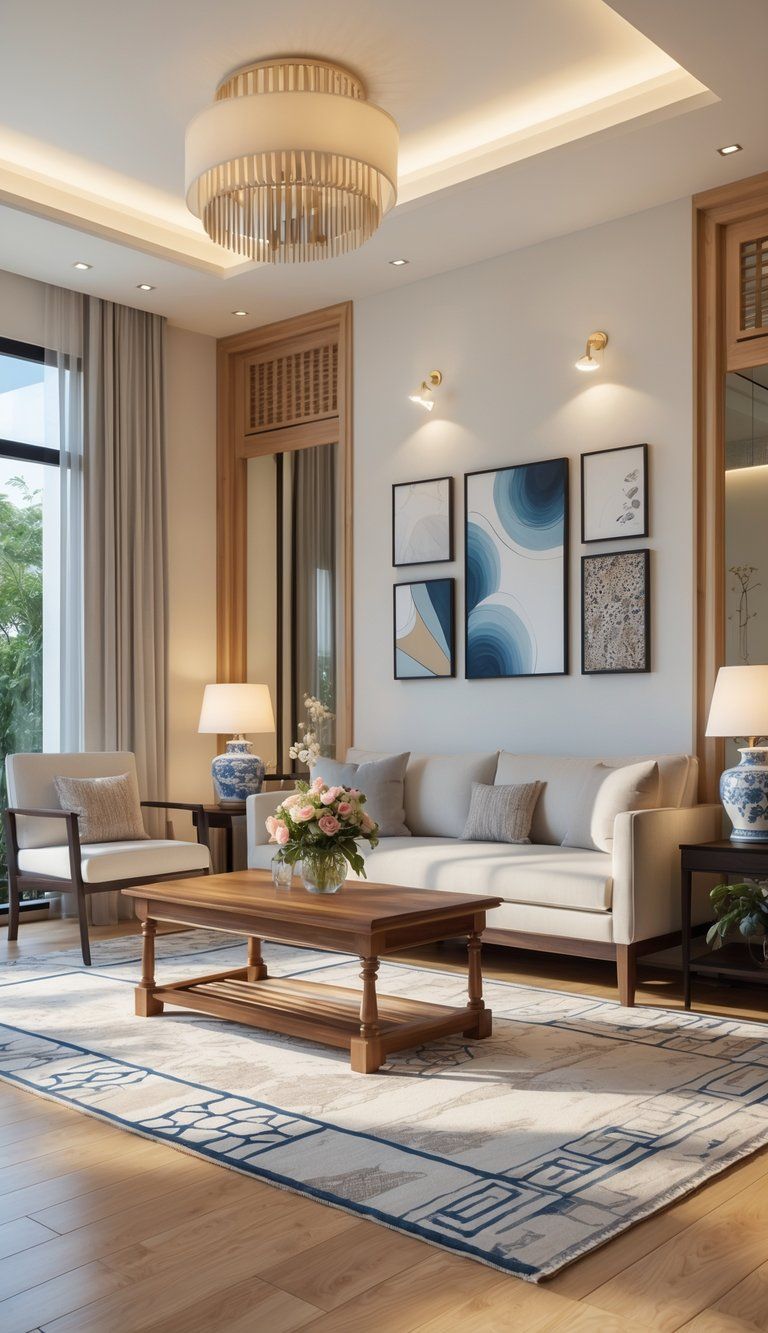
A lot of homeowners worry that mixing styles will just make things look chaotic. Actually, the contrast between old and new adds visual interest and depth that all-modern or all-traditional spaces often miss.
Picture a minimalist sofa next to an ornate antique coffee table, or bold modern art hanging above classic wainscoting.
Balance is the secret sauce here. You don’t need to split your home equally between modern and traditional.
Pick a dominant style, then bring in pieces from the other side as accents. This way, you get harmony, but also that exciting tension that makes blended spaces so captivating.
Overview of Modern and Traditional Home Design
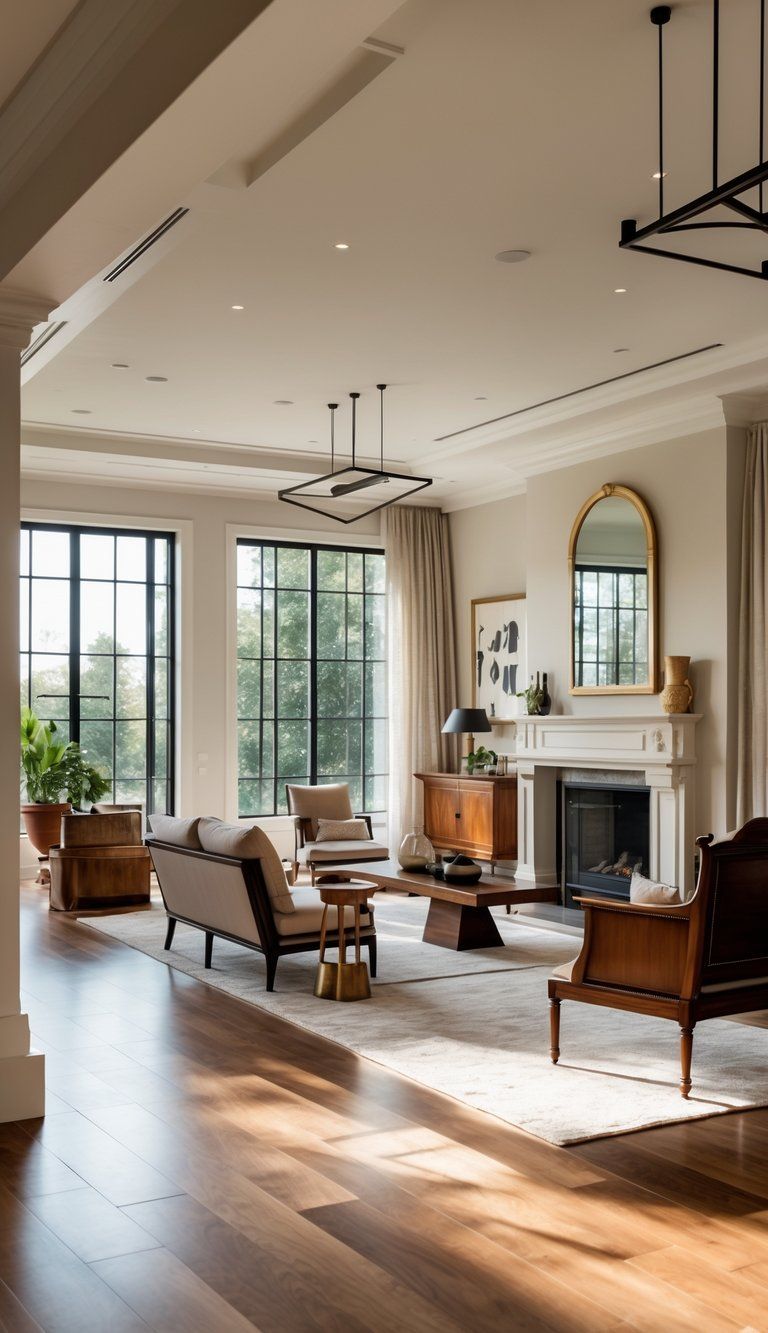
Home design styles have changed a lot over the years. Modern and traditional designs sit at opposite ends of the spectrum, but you can definitely blend them.
Each style has its own vibe and characteristics, and you can combine those in all sorts of ways.
Defining Modern Design
Modern design really took off in the early to mid-20th century. People wanted a break from super-ornate styles, so they started focusing on clean lines, minimal decoration, and functional spaces.
Modern homes usually have:
- Open floor plans and flowing spaces
- Big windows that let in tons of natural light
- Neutral color schemes, maybe with a pop of bold color
- Materials like glass, steel, and concrete
- Simple, sleek furniture
The idea is that “form follows function.” So, if something doesn’t serve a purpose, it’s probably not there.
You’ll find fewer knickknacks and more stuff that actually gets used.
Modern design also brings in technology in a subtle way. Smart home features just blend in, keeping everything looking calm and uncluttered.
Understanding Traditional Design
Traditional design takes its cues from 18th and 19th-century European styles. It feels warm and inviting, full of familiar touches that never really go out of style.
You’ll spot things like:
- Crown molding and wainscoting
- Rich wood tones and natural materials
- Symmetrical furniture arrangements
- Classic patterns—florals, plaids, stripes
- Antiques and heirlooms
Traditional rooms tell a story through collected items and time-tested design. Furniture tends to have curves and soft edges, making everything feel comfortable.
Colors lean toward warm neutrals, with accents like burgundy, navy, or forest green.
Key Contrasts and Commonalities
Modern and traditional styles really differ in how they approach decoration and visual weight. Modern spaces feel airy and light, while traditional rooms feel solid and grounded.
Big contrasts:
- Simplicity (modern) vs. ornamentation (traditional)
- Minimal (modern) vs. layered (traditional)
- New materials (modern) vs. tried-and-true (traditional)
But here’s the thing: both styles value craftsmanship and thoughtful design. Both can make beautiful, functional homes.
You can blend them by, say, pairing a traditional sofa with modern side tables, or adding modern lighting to a room with traditional trim.
Both styles are more flexible than people think. Modern doesn’t have to be cold, and traditional doesn’t have to be stuffy.
The Principles of Blending Styles
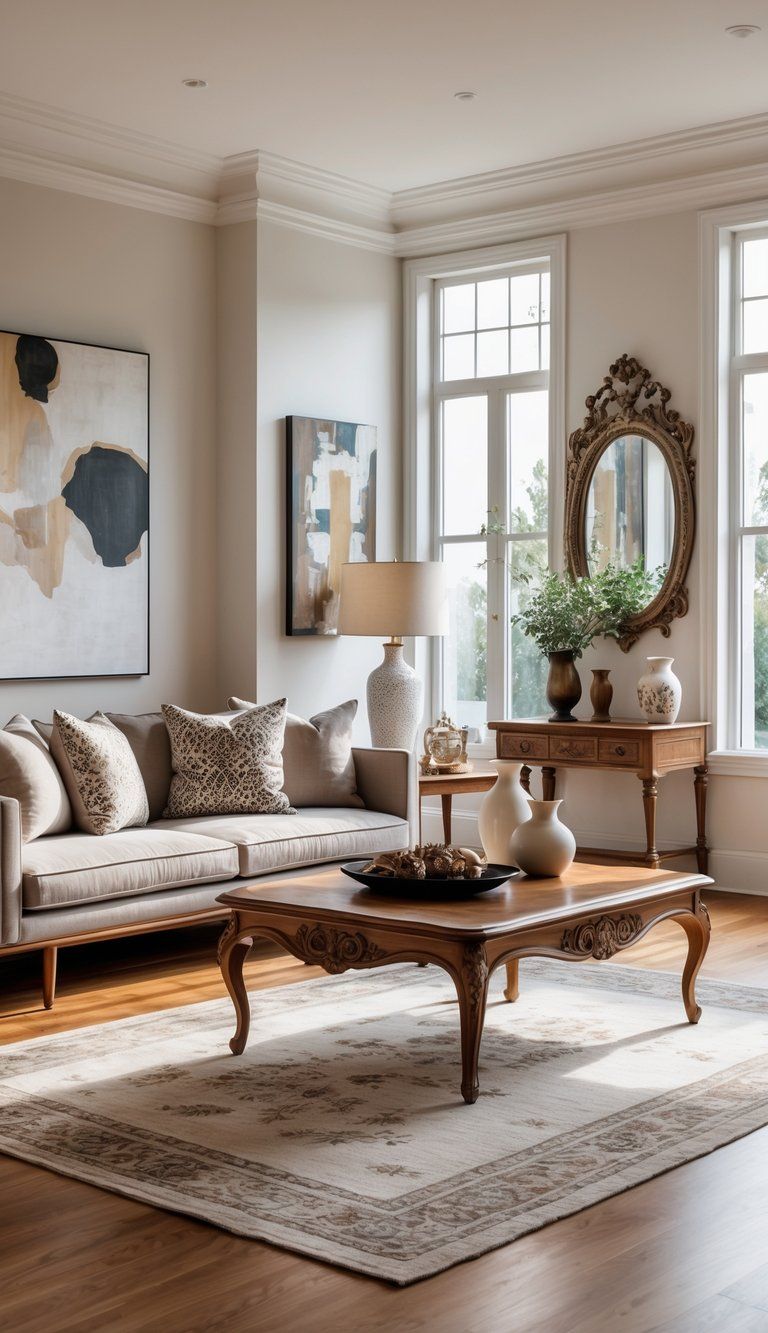
Blending styles is all about knowing a few key principles. These basics help you mix modern and traditional elements without making things feel disconnected or chaotic.
Finding the Balance Between Old and New
Balance really matters. When you mix styles, don’t aim for a perfect 50/50 split. Try a 70/30 or 60/40 ratio instead.
Pick a dominant style to set the tone. If you love modern, let it lead and use traditional pieces as accents.
A modern sofa with an antique coffee table? That combo just works.
Contrast keeps things interesting. Put sleek, modern furniture next to ornate, traditional pieces so each stands out.
Think about function too. Modern pieces usually bring practicality, while traditional ones add warmth and character.
Achieving Visual Harmony
Colors can make or break a blended room. Stick to a cohesive color scheme that works with both styles.
Neutral backgrounds let everything else shine.
Texture matters. Mix smooth modern surfaces with the rich, tactile feel of traditional design. A glass table and a patterned wool rug? Yes, please.
Use lighting to your advantage. Modern track lights can highlight traditional art or moldings beautifully.
Scale is important. Make sure your pieces play nicely together—a huge armoire next to a tiny side table will feel off.
Creating a Cohesive Look
Repetition ties everything together. Repeat colors, shapes, or materials in different spots to create unity.
If you’ve got brass in a traditional lamp, bring that into a modern light fixture too.
Transitional pieces can bridge the gap. These “in-between” items blend features from both styles, making the whole space flow better.
Area rugs that pull in colors from both styles help ground the space.
Personal touches make the room yours. Place family heirlooms next to contemporary art for a home that feels both timeless and personal.
Don’t forget about negative space. Give your rooms some breathing room so each piece stands out.
Choosing the Right Color Palette
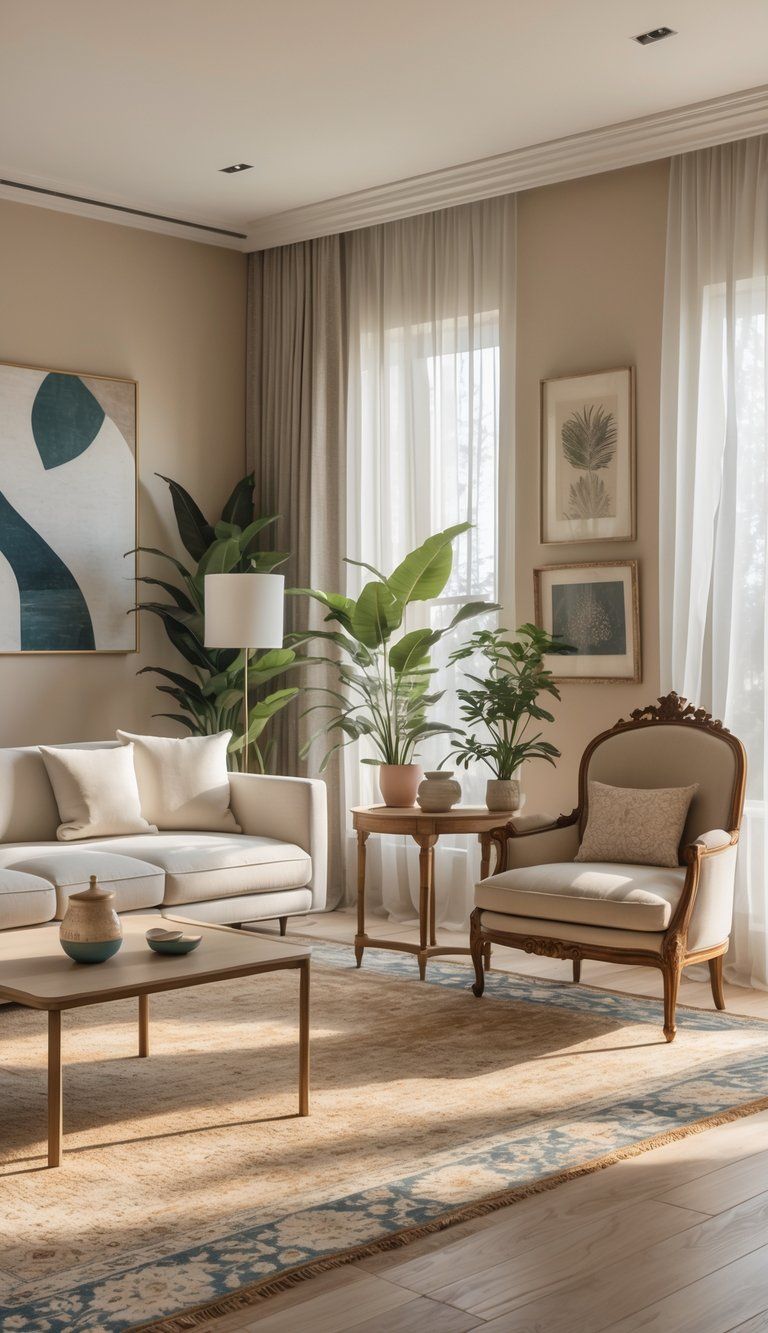
Blending modern and traditional styles starts with the right colors. A thoughtful palette brings harmony and sets the mood for your whole home.
Neutral Foundations
Begin with neutral tones as your base. Soft beiges, warm grays, ivory, and taupe create a backdrop that works with both modern and traditional elements.
Neutrals are like the peacekeepers between bold patterns and sleek lines. They help unify different pieces and details.
For walls, try:
- Warm whites—softer than pure white, but still fresh
- Greige—a nice middle ground between gray and beige
- Soft cream—adds warmth without going too yellow
Neutrals also make rooms feel bigger and more connected, especially if you use them throughout your home.
Incorporating Bold Accents
After you’ve set your neutral foundation, bring in bold accents for personality. These pops of color wake up a blended space.
Modern accents could be:
- Bright throw pillows
- Bold artwork
- Colorful accessories
Traditional accents might include:
- Jewel tones like emerald or sapphire
- Warm metals—brass or gold
- Deep wood finishes
Mustard yellow is a great accent for blended spaces. It feels classic but also fresh in small doses.
Try switching up accent colors with the seasons. Maybe soft blues in spring, deeper rusts in fall.
Contemporary and Classic Color Pairings
Some color combos just bridge the gap beautifully. They respect tradition but still feel fresh.
Try:
- Navy blue with crisp white (traditional) and brushed brass (modern)
- Muted greens with cream (traditional) and matte black (modern)
- Soft blues and gray (modern) with rich wood (traditional)
Balance cool and warm tones. Too many cool shades (grays, blues) can feel chilly. Too many warm ones (reds, oranges) might seem heavy.
Repeat your chosen colors in different rooms for a natural flow, but let each space have its own twist.
Exploring Textures and Patterns
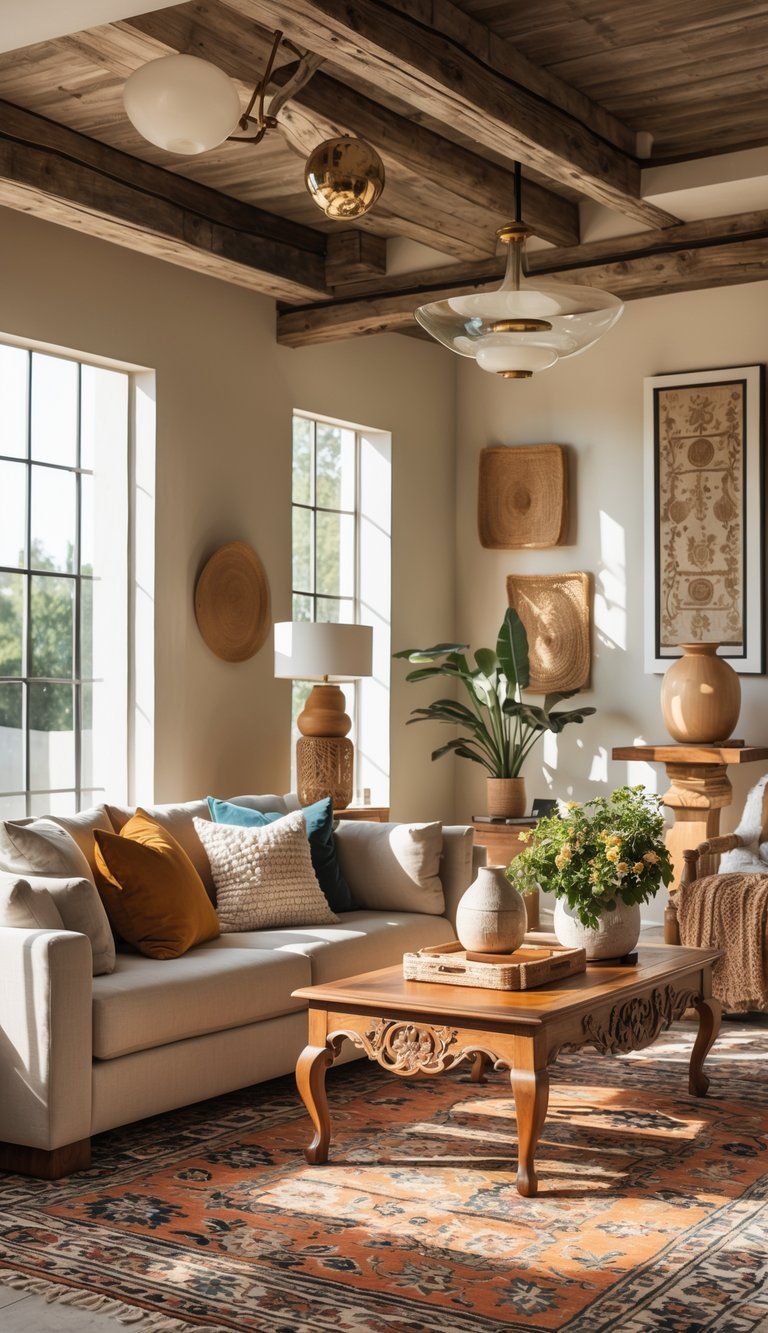
Textures and patterns can really pull modern and traditional styles together. They add depth and character, and keep rooms from feeling flat.
Layering Textures for Depth
Mixing textures gives your home dimension. Start with a neutral base, then layer on different textures.
Pair smooth modern surfaces with traditional, textured elements.
Try:
- Sleek glass or metal with rough-hewn wood
- Polished stone next to soft upholstery
- Smooth leather with chunky wool throws
Cozy textiles make modern spaces feel warmer. Toss velvet pillows on a clean-lined sofa, or drape a knit throw over a minimalist chair.
Contrast is your friend. Combining glossy and matte finishes creates visual tension and draws the eye.
Mixing Patterns Responsibly
Patterns can unite both styles if you use them with care. The trick is to balance bold contemporary designs with classic motifs.
Here’s what works:
- Vary the scale—mix big, medium, and small patterns
- Stick to a cohesive color palette
- Limit it to 3-4 patterns in one room
Geometric patterns bridge the gap nicely. Add modern geometric pillows to a traditional room, or classic patterns in unexpected colors to a modern space.
Leave some negative space. Every pattern needs a bit of breathing room.
Selecting Materials for Authenticity and Interest
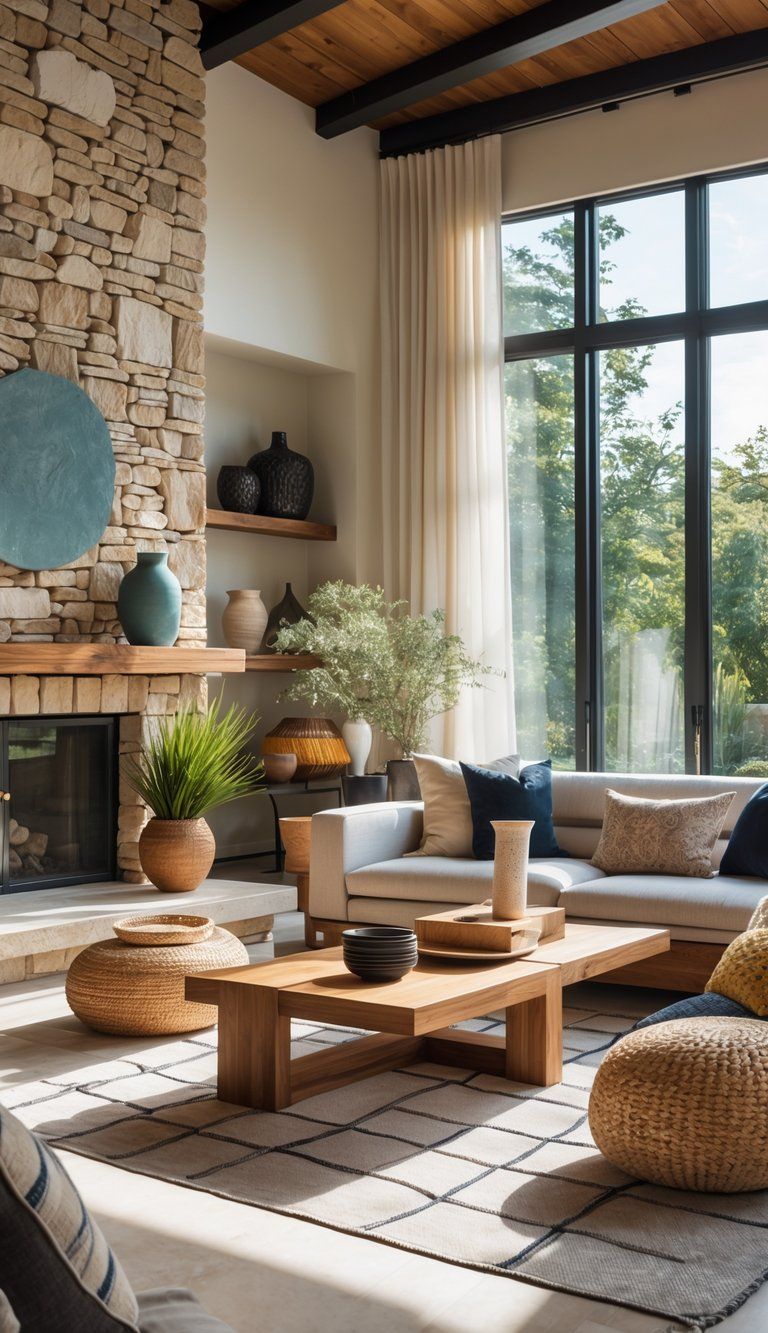
Materials are the backbone of any blended design. The right mix brings authenticity and excitement, letting both styles shine.
Natural and Traditional Materials
Stone brings timeless elegance to any room. Use limestone flooring in the kitchen or marble countertops for a classic touch.
These materials have history, and they instantly add authenticity.
Reclaimed wood tells its own story with every scratch and knot. Try it for:
- Floors with visible wear
- Accent walls that draw the eye
- Furniture with a little extra character
Exposed wood beams add rustic charm overhead. They look amazing in modern homes, creating contrast with clean lines.
Natural textiles like clay, wool, and cotton help ground a space. Mix them up—a wool rug under a glass coffee table creates a beautiful tension between old and new.
Modern Materials and Finishes
Sleek metals like stainless steel, brass, and copper make perfect counterpoints to traditional elements. You might see them pop up in:
- Light fixtures with mixed metal finishes
- Hardware on classic cabinetry
- Furniture frames paired with traditional upholstery
Glass brings in light and a sense of openness. Large windows with minimal frames or glass tabletops lighten up rooms filled with heavier traditional furniture.
Concrete adds surprising versatility. People use polished concrete floors under traditional rugs, or pair concrete countertops with wooden cabinets for a cool mix.
Metal accents look best in small doses. Place a chrome lamp on an antique table or add brass hardware to a traditional sideboard for balance without going overboard.
Furniture and Decor: Mixing Eras with Intent
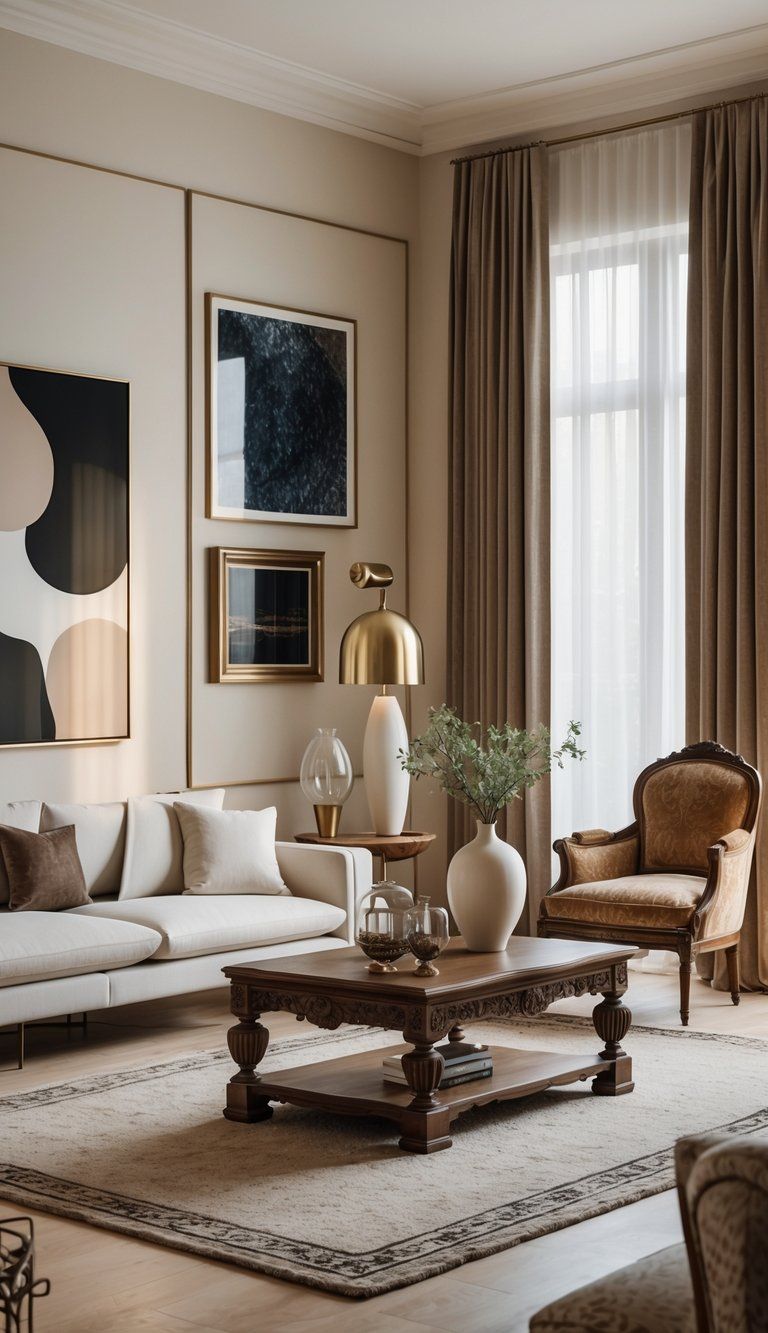
Blending furniture from different eras makes spaces feel personal and timeless. When you thoughtfully mix traditional craftsmanship with modern simplicity, you add depth and character to your home.
Combining Contemporary and Vintage Pieces
Finding balance is the secret sauce for mixing eras. Try pairing a sleek, low-profile modern sofa with an ornate antique coffee table for instant visual interest.
Look for complementary elements when combining pieces. A vintage wooden dresser can work beautifully with contemporary chairs if they share similar wood tones or hardware.
Scale really matters. Make sure your pieces don’t fight for attention. If you have a large traditional armoire, give it breathing room with smaller modern side tables instead of another big piece.
Tips for Successful Mixing:
- Use color as a unifying thread
- Stick to consistent proportions
- Pick quality pieces from both eras
- Leave negative space around statement items
Incorporating Statement Pieces
Every room comes alive with a bold statement piece that anchors the space. Maybe it’s a dramatic chandelier, an oversized mirror with a gilded frame, or a vibrant modern art installation against traditional wallpaper.
Statement pieces shine brightest when they have space. If you go for a large traditional secretary desk as your focal point, keep the modern pieces around it simpler and more subdued.
Effective Statement Elements:
- Sculptural modern lighting in classic rooms
- Bold contemporary art above timeless furniture
- Vintage rugs in minimalist spaces
- Repurposed architectural salvage as art
That old-meets-new contrast creates visual tension and keeps things interesting. A mid-century modern chair in plush velvet can make traditional wood furniture feel surprisingly fresh.
Heirlooms and New Finds
Family heirlooms carry stories and history you just can’t get from new pieces. Update them with new hardware or contemporary textiles to help them blend with newer finds.
You don’t have to keep heirlooms exactly as they are. Reupholster a traditional chair in modern geometric fabric, or paint a vintage cabinet in a fresh color to give it new life.
Meaningful juxtapositions work well—display family photos in sleek modern frames or set handcrafted accessories on minimalist shelves. This way, you honor tradition while embracing current design sensibilities.
Patina and wear on vintage items add character that pristine new pieces just can’t match. These imperfections tell stories and add soul, especially when you pair them with crisp contemporary elements.
Lighting: Uniting Styles Through Ambiance
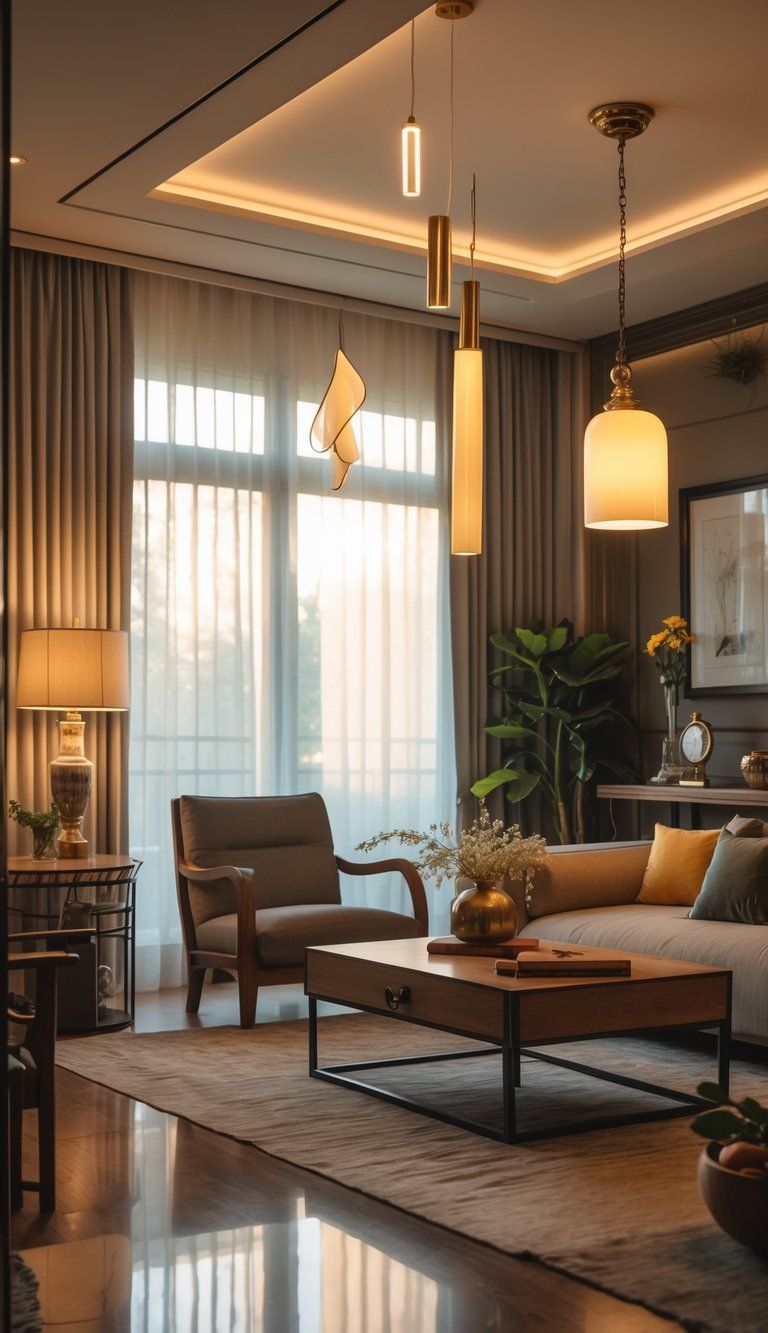
Lighting bridges modern and traditional design. It sets the mood, highlights features, and can transform a space without big renovations.
Maximizing Natural Light
Natural light is the foundation of any great home. It shows off your decor and creates a warm, welcoming vibe that works for both modern and traditional styles.
Keep window treatments minimal where you can. Sheer curtains or simple blinds let in more light and keep things looking clean.
Mirrors can bounce natural light around. Try placing them opposite windows to brighten up darker corners.
Glass-paneled doors or transom windows add a traditional touch and boost light flow between rooms.
Light-colored paint on walls and ceilings helps, too. Soft whites or pale neutrals look good in both traditional and modern settings.
Statement Lighting Fixtures
A standout lighting fixture can tie your blended style together. This is where you can make a bold choice that fits both worlds.
Mix vintage-style chandeliers with sleek modern finishes for a fun twist. A crystal chandelier with matte black hardware? Instant wow factor.
Pendant lights in traditional shapes but made from modern materials look great. Glass pendants with Edison bulbs bring nostalgia and modern flair.
Layer your lighting for options. Combine overhead lights, task lamps, and accent lighting to set different moods.
Bulb temperature matters more than you’d think. Warmer light (2700-3000K) works well in traditional spaces, while cooler tones fit modern areas. Smart bulbs let you adjust as needed.
Room-by-Room Approaches

Different rooms call for different approaches when you blend modern and traditional styles. Each space has its own purpose and vibe that you can enhance with thoughtful choices.
Modern-Traditional Living Room
The living room is a great place to mix styles. Start with a traditional base like crown molding or a classic fireplace mantel. Then bring in modern touches with furniture and decor.
A streamlined neutral sofa grounds the room. Pair it with a traditional wingback chair in a contemporary fabric for a nice contrast.
Try mixing a modern floor lamp with a traditional table lamp for lighting. It keeps things interesting but not chaotic.
Art can bridge styles, too. Modern abstract pieces pop against classic wall treatments.
Living Room Blending Tips:
- Define areas with patterned rugs
- Mix metals (brass, matte black)
- Balance symmetrical (traditional) and asymmetrical (modern) setups
Bedroom Blends
Bedrooms should feel restful and personal, even when you blend styles. The bed frame usually grabs attention—try a modern platform bed with traditional quilting, or the other way around.
Nightstands don’t have to match. Use a traditional wooden piece on one side and a sleek modern table on the other for intentional contrast.
Window treatments offer another spot to play. Combine modern blinds with traditional drapes for style and function.
Wall decor can mix it up, too. A gallery wall with vintage portraits and abstract prints in matching frames works well.
Comfort elements to consider:
- Bedding with classic patterns in modern colors
- Statement lighting that contrasts with your bed
- Minimalist seating with traditional textiles
Functional Living Spaces
Kitchens and bathrooms need style and practicality. In kitchens, cabinets make a big impact. Try modern flat-panel drawers below and traditional glass-front cabinets above.
Countertops are a good place for contrast. Modern quartz pairs nicely with classic backsplash tiles.
In bathrooms, fixture style matters. A traditional claw-foot tub with a modern vanity adds instant character.
Flooring can pull your vision together. Large-format tiles in traditional patterns give you the best of both worlds.
Functionality boosters:
- Hide modern storage behind classic facades
- Use smart technology in traditional forms (like classic-look appliances with modern guts)
- Multipurpose furniture that looks great and works hard
Cultural Fusion and Personal Narratives
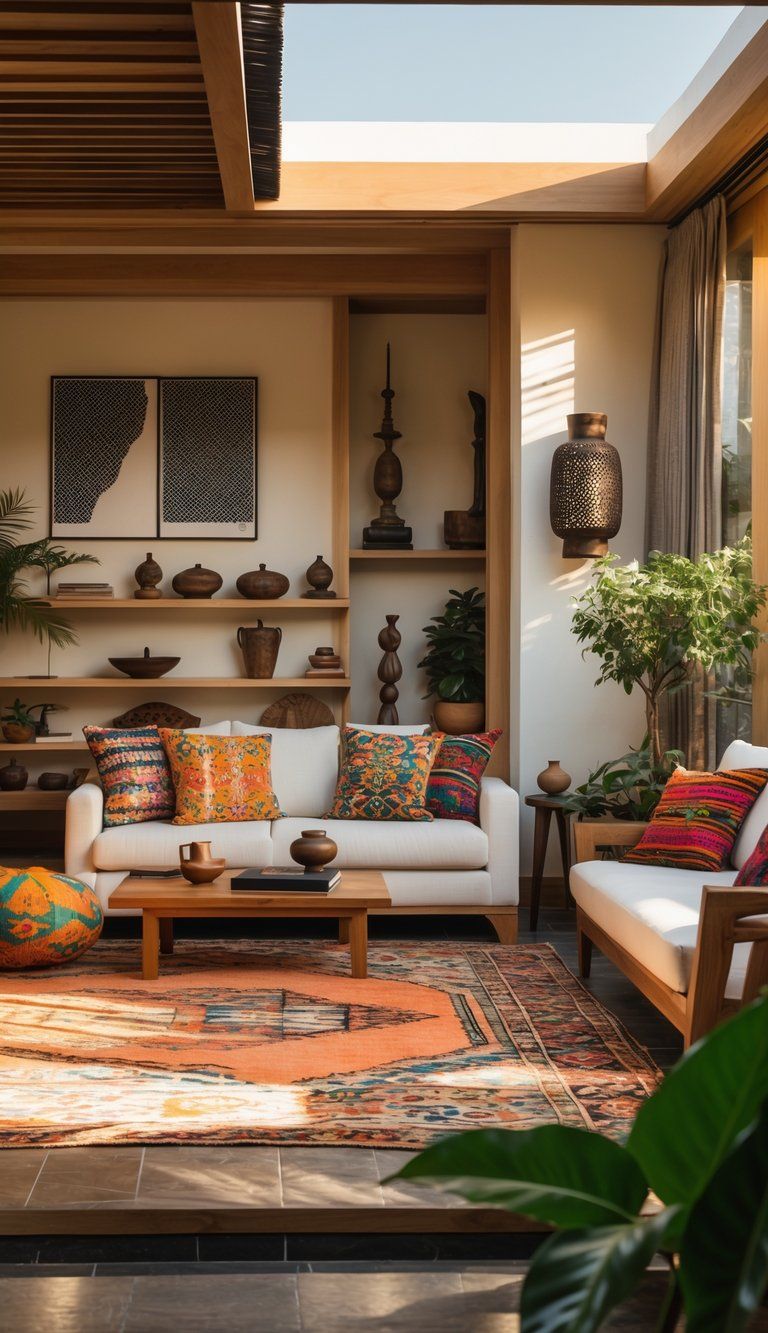
Blending cultural elements in your home lets you tell your story and honor influences from around the globe.
Showcasing Cultural Heritage
Your home can showcase your personal history and roots. Bring in family heirlooms like your grandmother’s handwoven rug or traditional artwork that reflects your ancestry.
Display items from your travels—a wooden mask from West Africa or pottery from Mexico—to spark conversation and memories.
Traditional textiles make great focal points. Try Indian saris as curtains or Moroccan blankets as wall hangings for texture and meaning.
Architectural touches can highlight heritage, too. Consider:
- Carved wooden screens inspired by Middle Eastern designs
- Japanese-style sliding doors
- Decorative tiles from your cultural background
Thoughtfully displayed photos and memorabilia add another personal layer.
Celebrating Diversity and Fusion
Cultural fusion shines in unexpected combinations. Japandi style, for example, blends Japanese minimalism with Scandinavian function for serene, natural spaces.
Create your own mix by combining design elements from different cultures that resonate with you. Maybe pair clean-lined Scandinavian furniture with colorful Turkish rugs or Chinese porcelain.
Color schemes can reflect multiple influences. Mediterranean blues with earthy African tones? That can look vibrant and balanced.
Food spaces are perfect for fusion. Install an Italian pizza oven next to a traditional wok station if that’s your thing.
Authentic fusion comes from real appreciation, not just borrowing. Take time to understand the significance of elements from other cultures before you bring them in.
Maintaining Functionality and Comfort
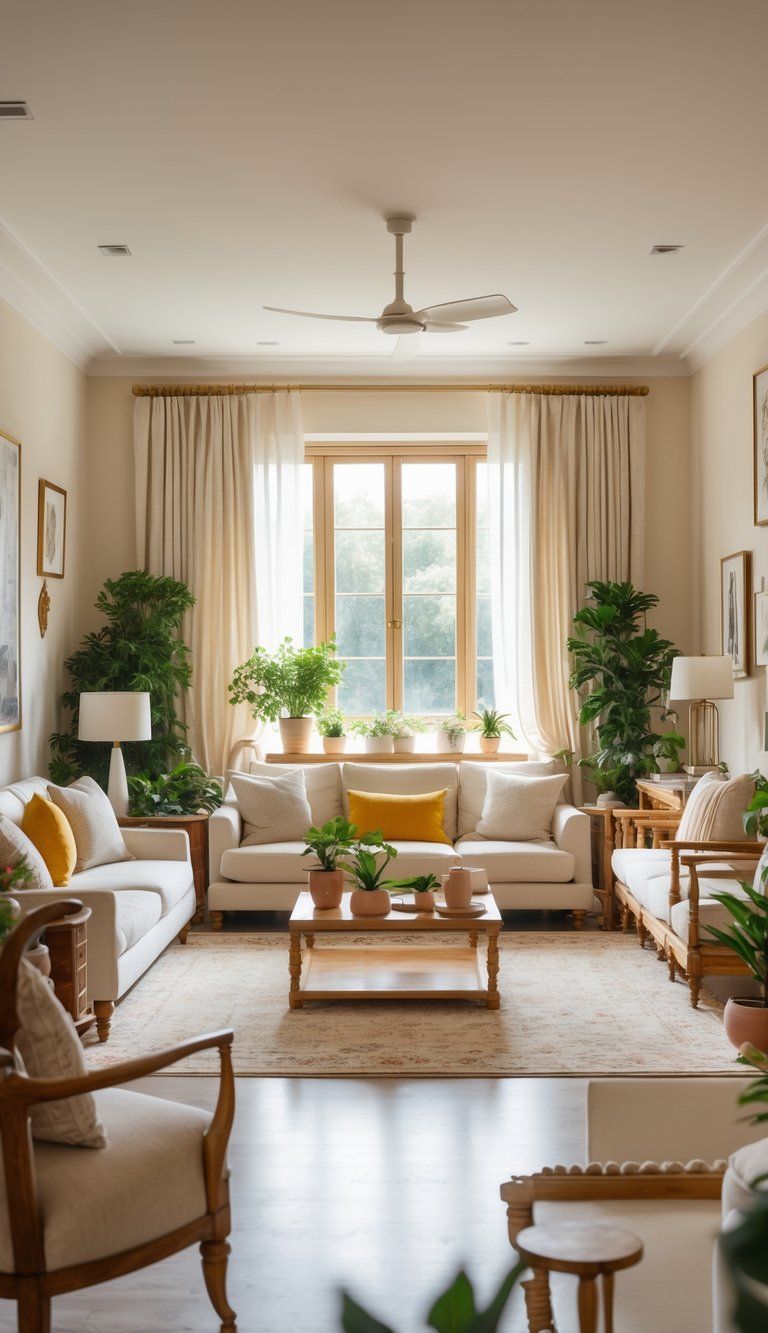
Blending traditional and modern styles should keep your home practical and comfortable. Finding the right balance means your spaces look good and work for your daily life.
Prioritizing Modern Conveniences
Modern tech fits right into traditional spaces with a little creativity. Hide smart devices in vintage-style cabinets or boxes so you keep the look but enjoy the perks. In kitchens, try appliances with retro designs but modern guts—lots of brands make fridges and stoves that look old-school but work like new.
Lighting deserves attention. Dimmable LED bulbs in antique fixtures save energy and keep the charm. In bathrooms, pair clawfoot tubs with modern plumbing for style and efficiency.
Tuck entertainment systems into traditional furniture. Media cabinets with sliding panels or TV lifts hide tech when you’re not using it.
Designing for Uncluttered Spaces
Clean lines let traditional pieces shine. Choose a few standout vintage items instead of crowding rooms with collectibles. This keeps things focused and gives everything space to breathe.
Built-in storage is your friend. Custom cabinets with classic molding can stash modern stuff out of sight. Try:
- Window seats with hidden storage
- Ottomans that open up for blankets
- Vintage trunks as coffee tables
Open shelving looks best when you keep it disciplined. Show off just your most meaningful traditional pieces and keep the rest tucked away.
Furniture placement matters, too. Leave clear pathways and avoid overcrowding. A single antique chair can stand out without making the space feel cramped.
Incorporating Modern Trends Without Losing Tradition
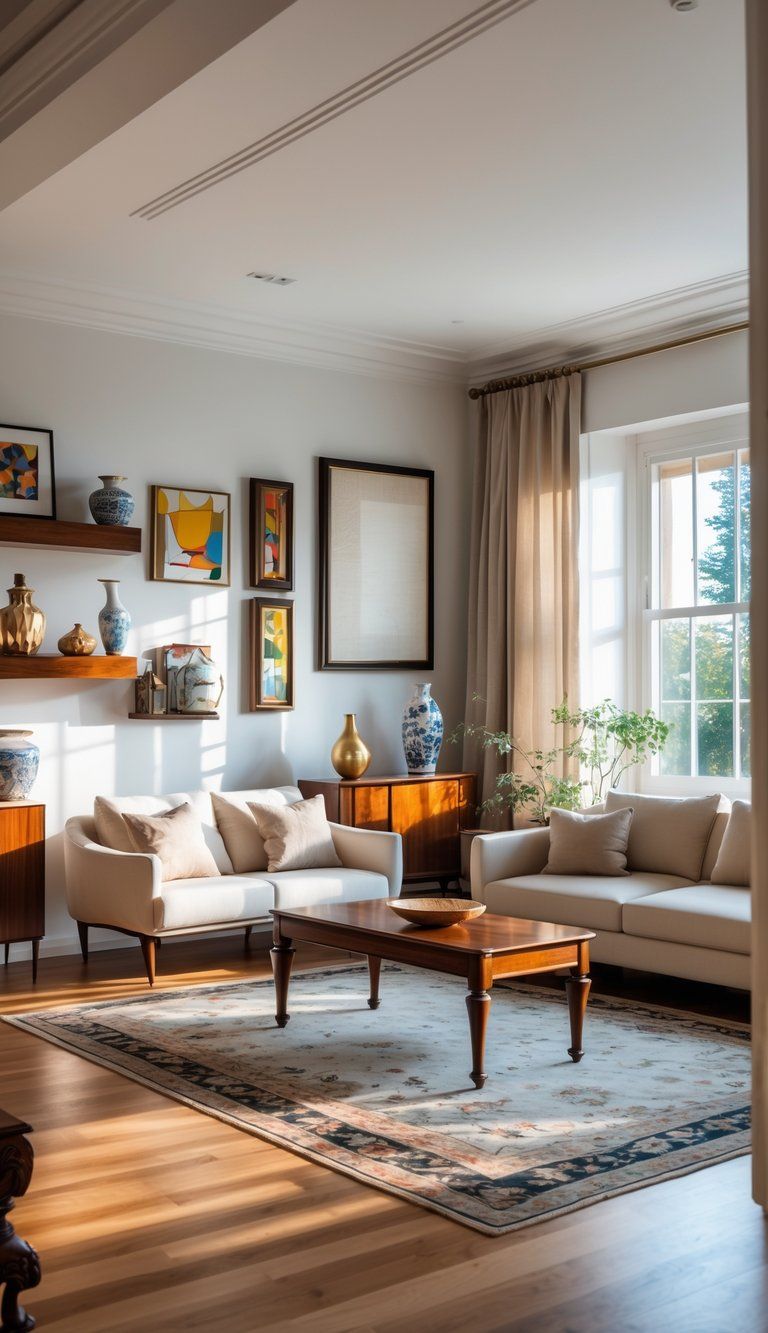
Blending modern trends with traditional elements keeps your home feeling fresh and timeless. The trick is balancing new ideas with classic features that have real staying power.
Mindful Consumption and Sustainability
Designers today talk a lot about making sustainable choices that respect tradition and the planet. You can bring this mindset home without losing that appreciation for craftsmanship.
Look for furniture made from reclaimed wood. Makers who use traditional construction methods but give pieces a fresh shape create items that tell a story and cut down on waste.
You can hide smart home tech inside classic details. Maybe that thermostat lives behind a vintage switch plate, or speakers disappear into crown molding. Who would guess?
Go for quality, not quantity. Instead of filling your space with throwaway decor, pick a few well-made pieces that last. This fits with both traditional values and modern sustainability—kind of a win-win.
Pick natural fabrics like wool, cotton, or linen for your textiles. These materials have always worked and they’re making a comeback in new designs because they’re sustainable and never really go out of style.
Staying on Top of Design Trends
Modern trends can actually play nicely with traditional spaces if you use them thoughtfully. The farmhouse look does this well, mixing rustic touches with crisp, modern lines.
Check out design blogs and magazines to spot trends that might fit your place. You don’t need to chase every fad—just pick what feels right for your home’s vibe.
Paint is a low-commitment way to try out color trends. Maybe go bold with a contemporary shade on one wall, even in a classic room.
Lighting gives you another shot at mixing things up. Imagine a minimalist pendant hanging over a traditional dining table—suddenly, there’s this cool contrast.
Try mixing materials on purpose. Pair a classic wood dresser with a modern glass lamp or a metal accent. Done right, the space feels balanced—not random.
Enhancing Indoor-Outdoor Connections
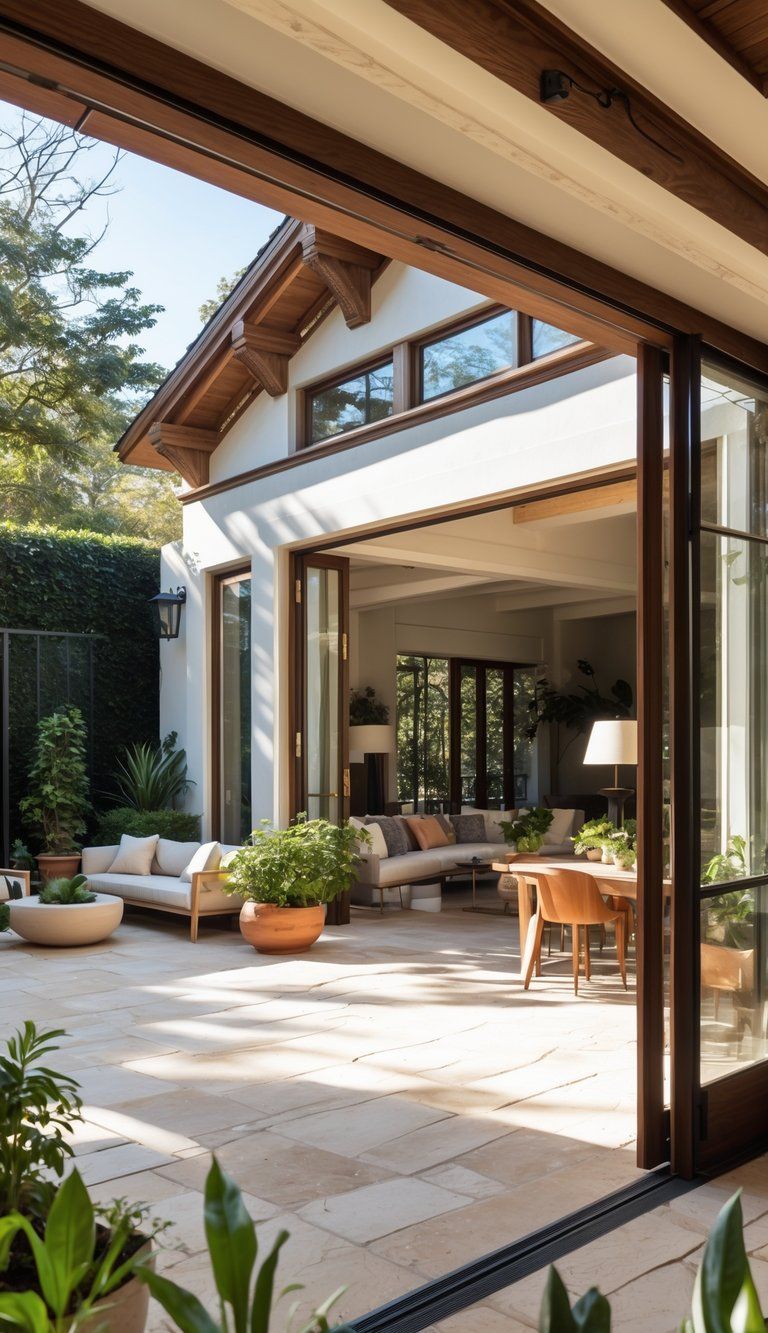
You can add value to your home (and make it feel bigger) by connecting indoor and outdoor spaces. This approach brings together indoor comfort and outdoor beauty.
Seamless Indoor-Outdoor Living
Large glass doors do wonders for connecting inside and out. Slide or fold them open and suddenly your patio feels like part of the living room.
Flooring matters more than you’d think. Use the same material inside and out—like weather-resistant tile or concrete—and you’ll get a sense of flow.
Arrange furniture so it faces the view outside. Even just turning a sofa toward the window makes the whole room feel more open and connected to nature.
Lighting ties the spaces together. Use similar fixtures inside and out for a unified look. String lights or lanterns outside can echo your indoor style.
Utilizing Outdoor Spaces
Turn your patio or deck into a real outdoor room. Add comfy seating, weather-resistant rugs, and a side table or two. Suddenly, you’ve got another living area.
Popular Outdoor Room Types:
- Dining spots with a sturdy table and chairs
- Lounging zones with sofas or coffee tables
- Cooking areas with a grill or even a full outdoor kitchen
Plants really help blur the line between indoors and outdoors. Bring some potted plants inside, or cluster houseplants near the doors.
Covered spots like pergolas or awnings can make your outdoor space usable through more of the year. You’ll get extra living space without worrying about the weather.
Bring in smart tech if you want. Weatherproof speakers, TVs, and lighting can make your patio as comfortable as your living room.
Curating Accessories and Artful Details
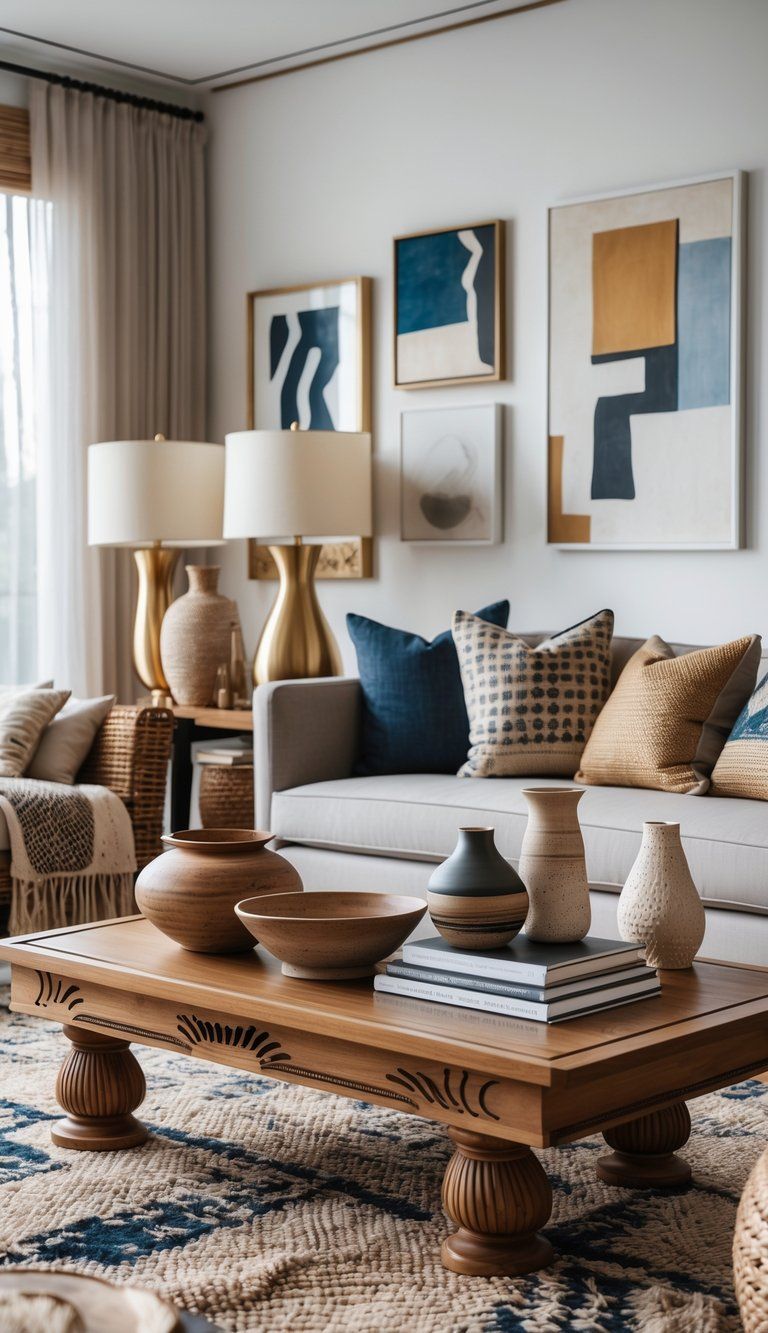
It’s the finishing touches that turn a house into a home. Accessories can bridge modern and traditional styles while letting your personality shine through.
Personalized Wall Art
Wall art is a great way to show off your style and connect different design elements. Maybe hang a classic oil painting in a modern frame, or pick new artwork that nods to old-school themes.
Gallery walls can look fantastic in transitional spaces. Try mixing vintage family photos with bold modern prints for a mix that feels collected, not chaotic.
Think about the size of your art. A big landscape can ground a modern space, while smaller contemporary pieces can freshen up a room full of antiques.
Your art doesn’t have to match your furniture exactly. Let it complement the room—sometimes the right colors in a painting pull everything together.
Accent Pieces That Tie Styles Together
Small accessories can really make a space pop when you’re mixing styles. Try to find pieces that blend both traditional and modern vibes.
- Books – Stack a few leather-bound classics next to a bold, contemporary coffee table book.
- Vases – Set a mercury glass vase beside a sleek, ceramic one.
- Throw pillows – Toss in traditional patterns, but pick modern colors or unexpected fabrics.
Metals work wonders as style bridges. I love how a brass lamp with sharp lines or a shiny chrome frame on an old-school mirror just brings it all together.
Stick to a consistent color palette. Even if your styles clash a bit, the colors will tie everything together.
Don’t overload your surfaces. Pick a handful of meaningful pieces instead of scattering lots of little things everywhere.
Quality stands out way more than quantity when you want a blended space to feel polished.

